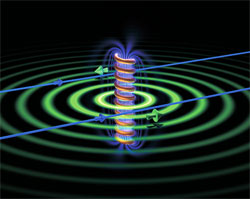Landmarks: Ghostly Influence of Distant Magnetic Field
Focus Landmarks feature important papers from the archives of the Physical Review.
A 1959 Physical Review paper claimed that an electric or magnetic field could influence quantum particles even though the particles never experienced the field directly. In classical electromagnetism there is no other way to influence a particle besides direct contact with the fields. Even though quantum mechanics was well-established by then, the idea met with widespread skepticism. Arguments over the theoretical analysis and attempts at experimental verification continued for some years, but eventually the so-called Aharonov-Bohm effect took its place as a legitimate demonstration of unexpected physics in the quantum world.
In classical electromagnetism, electric and magnetic fields are the fundamental entities responsible for all physical effects. There is a compact formulation of electromagnetism that expresses the fields in terms of another quantity known as the electromagnetic potential, which can have a value everywhere in space. The fields are easily derived theoretically from the potential, but the potential itself was taken to be purely a mathematical device, with no physical meaning.
In quantum mechanics, the electromagnetic potential alters the descriptions of charged particles only by shifting their phase–that is, by advancing or retarding the crests and troughs in their quantum wavefunctions. In general, however, such a phase change does not lead to any difference in the measurable properties of a particle.
But in 1959 Yakir Aharonov and David Bohm of the University of Bristol, England, devised a “thought experiment” that linked the potential to a measurable result. In their scenario, a beam of electrons is split, with the two halves made to travel around opposite sides of a cylindrical electromagnet, or solenoid. The magnetic field is concentrated inside the solenoid and can be made arbitrarily weak outside by making the cylinder extremely narrow. So Aharonov and Bohm argued that the two electron paths can travel through an essentially field-free region that surrounds the concentrated field within the electromagnet.
In this field-free region, however, the electromagnetic potential is not zero. Aharonov and Bohm showed theoretically that electrons on the two paths would experience different phase changes, and that recombining the electron beams would produce detectable interference effects. That is, the intensity of the recombined beam would vary according to whether the phase-shifted wavefunctions reinforced or canceled each other–a measurable physical effect directly related to the potential, contrary to standard wisdom. However, the phase shift can also be calculated from the strength of the magnetic field, so that interference can be interpreted as an effect of a magnetic field that the electrons never actually pass through. Aharonov and Bohm argued that physicists must accept that in quantum mechanics the electromagnetic potential has genuine physical significance. They expanded on this point in a second paper in 1961 [1].
The Aharonov-Bohm paper “created a sensation,” says Murray Peshkin, now at Argonne National Laboratory in Illinois. The troubling issue was that a quantum mechanical measurement required what seemed to be an untenable interpretation of the electromagnetic potential. “There were lots of papers trying to make Aharonov-Bohm go away, or saying there was something wrong with the calculation,” Peshkin says, but after about five years the criticism faded. It also emerged that a paper published ten years earlier [2] had hinted at the effect, but Peshkin, and also Michael Berry of the University of Bristol, have recently argued that Aharonov and Bohm nevertheless deserve credit for properly understanding the effect that bears their name [3].
Experimental papers demonstrating the effect began to appear soon after the first Aharonov-Bohm paper [4] but they too were criticized, often on the grounds that the paths on which the electrons traveled were not strictly devoid of magnetic field. Such criticisms were empty, Peshkin says, because no one showed how tiny residual fields could cause the measured effect. Still, it wasn’t until physicists performed an experiment in which the electromagnet was shielded by a superconducting screen, which rigorously blocked the magnetic field [5] that any remaining doubts about the Aharonov-Bohm effect were finally put to rest.
–David Lindley
David Lindley is a freelance science writer in Alexandria, Virginia.
References
- Y. Aharonov and D. Bohm, “Further Considerations on Electromagnetic Potentials in the Quantum Theory,” Phys. Rev. 123, 1511 (1961)
- W. Ehrenberg and R. E. Siday, “The Refractive Index in Electron Optics and the Principles of Dynamics,” Proc. Phys. Soc. (London) B62, 8 (1949)
- M. Berry, Physics Today 63, 8 (2010); M. Peshkin, 63, 8 (2010)
- R.G. Chambers, “Shift of an Electron Interference Pattern by Enclosed Magnetic Flux,” Phys. Rev. Lett. 5, 3 (1960); G. Möllenstedt and W. Bayh, "Physikalische Blätter 18, 299 (1961)
- N. Osakabe, T. Matsuda, T. Kawasaki, J. Endo, A. Tonomura, S. Yano, and H. Yamada, “Experimental Confirmation of Aharonov-Bohm Effect Using a Toroidal Magnetic Field Confined by a Superconductor,” Phys. Rev. A 34, 815 (1986)
More Information
Physics Today article from 2009 on experimental tests of the Aharonov-Bohm effect and related phenomena (requires subscription)





